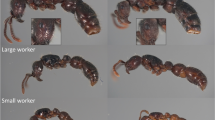Summary
The reproductive partitioning generates a persistent conflict within insects societies and a sustained theoretical and empirical attention is devoted to understand its resolution. In that context, thelytokous parthenogenesis by workers is an intriguing phenomenon where each individual is virtually reproducing. This reproductive strategy, scarce among Formicidae, was studied in C. biroi, an obligatory thelytokous cerapachyine ant. Particularly, we searched for a reproductive division of labour in colonies assumed to be clonal. The results revealed that no sterile caste was present in the colonies. However, reproduction was linked both to a temporal polyethism, in which older workers ceased to lay as they became foragers, and to a morphological polyethism, illustrated by two morphological types of individuals displaying different task allocations and ovary capacities. Evolutionary implication of this uncommon social structure, seemingly free of traditional conflict and characterised by a reproduction evenly distributed among nestmates, is discussed from comparisons to other ant species with extreme kin structure.
Similar content being viewed by others
Author information
Authors and Affiliations
Corresponding author
Additional information
Received 18 June 2003; revised 6 August 2003; accepted 7 August 2003.
Rights and permissions
About this article
Cite this article
Ravary, F., Jaisson, P. Absence of individual sterility in thelytokous colonies of the ant Cerapachys biroi Forel (Formicidae, Cerapachyinae). Insect. Soc. 51, 67–73 (2004). https://doi.org/10.1007/s00040-003-0724-y
Issue Date:
DOI: https://doi.org/10.1007/s00040-003-0724-y




